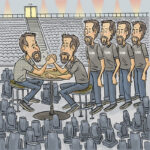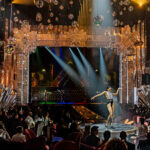The most commonly used type of macro is often referred to as a “trigger” macro. Typically, this is a series of short commands that are added to a cue, sequence, page change, view, or other console operation. These pre-defined commands allow the programmer to initiate a command at the same instance as a different action. For instance, a trigger macro can start chase 22 when cue 4 of a cuelist is played. By adding a unique trigger macro “code” to cue 4, the console knows to automatically start chase 22 whenever cue 4 is played. Trigger-type macros are extremely powerful because they let programmers create complex triggering structures with very simple commands. Quite often, these are used within programming to automate tasks that would be difficult to accomplish manually. At other times, they are used to turn on or off various playbacks. In addition, trigger macros can be used for other console events such as page or view changes, thus changing the state of the console when certain cues are played. Trigger macros can often be triggered not only by playbacks, but by other events such as clock triggers, page changes or MIDI events.
—Brad Schiller, from “Feeding the Machines,” PLSN, Oct. 2011


